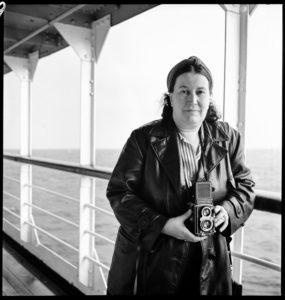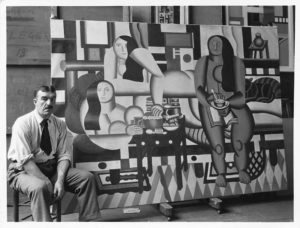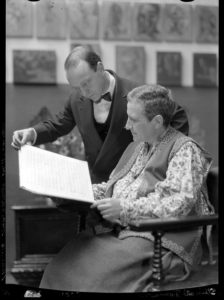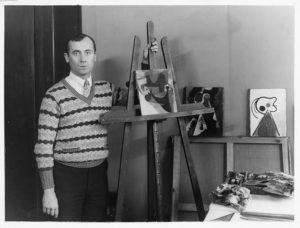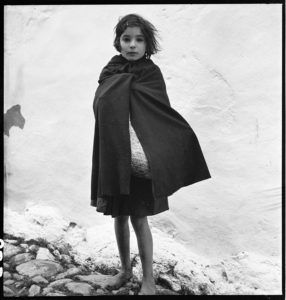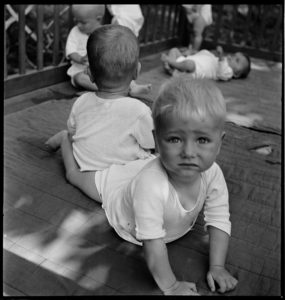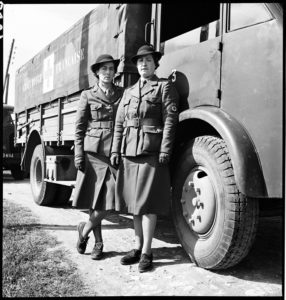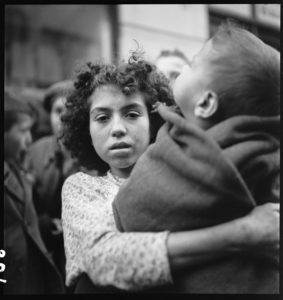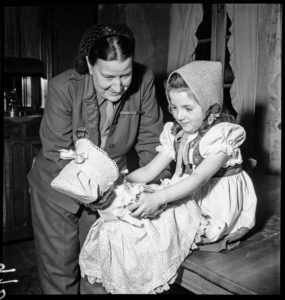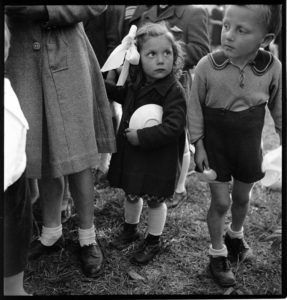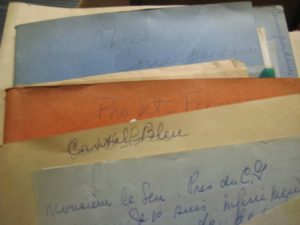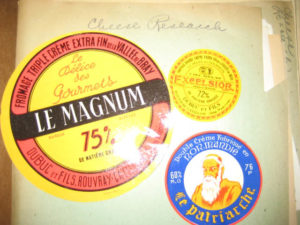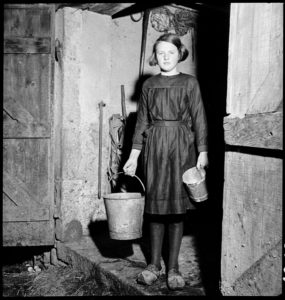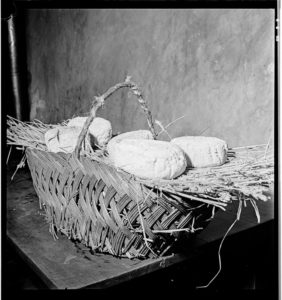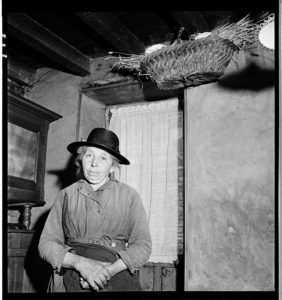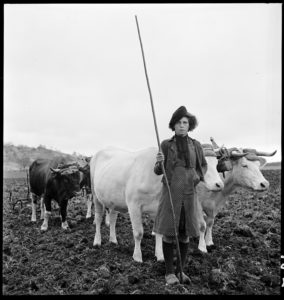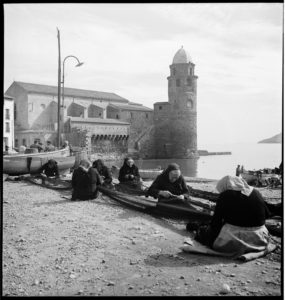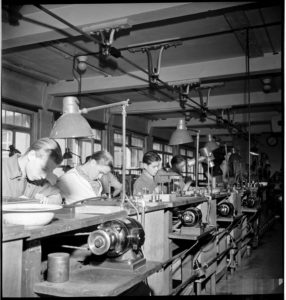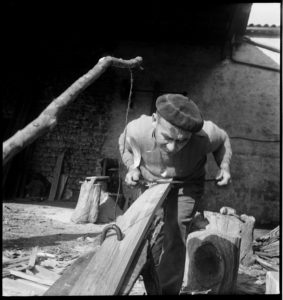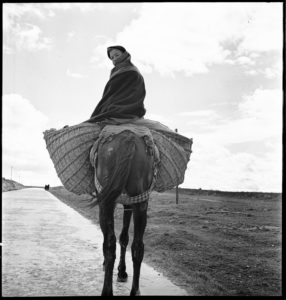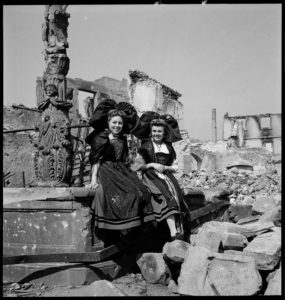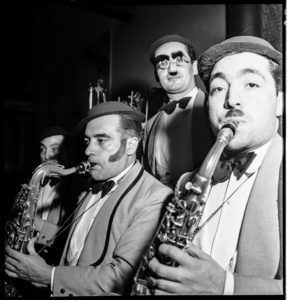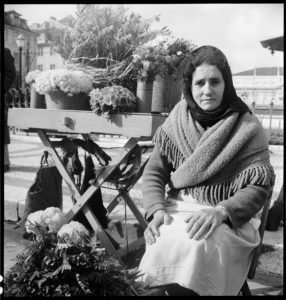Tag: collection processing
Thérèse Bonney: Art Collector, Photojournalist, Francophile, Cheese Lover
Thérèse Bonney aboard the S.S. Siboney, en route to Portugal, 1941. BANC PIC 1982.111 series 3, NNEG box 49, item 19
Pioneering war correspondent and Cal grad Mabel Thérèse Bonney (1894-1978) was decorated with the Croix de Guerre and the Legion d’Honneur by the French government, and the Order of the White Rose of Finland for her work during World War II. Her photographs were exhibited at the Museum of Modern Art, the Library of Congress, and Carnegie Hall during her lifetime. Her work on children displaced by war spurred the United Nations to create their international children’s emergency fund, UNICEF, in 1946, and inspired the Academy Award-winning film The Search in 1948. Yet in the canon of female war photographers that includes contemporaries such as Lee Miller, Margaret Bourke-White, and Toni Frissell, Bonney rarely receives mention. Bonney was a renaissance woman whose life deserves further study, and her collections at the Bancroft Library are ripe for discovery. Manuscript Archivist Marjorie Bryer has processed The Thérèse Bonney papers, and Pictorial Archivist Sara Ferguson has digitized over 2,500 previously inaccessible nitrate negatives from the Thérèse Bonney Photograph Collection.
ART CONNOISSEUR
While living in Paris in the 1920s and 1930s, Bonney modeled for fashion designers like Sonia Delaunay and Madeleine Vionnet, and became friends with many of the most famous artists and writers of her day, including Raoul Dufy, Gertrude Stein, and George Bernard Shaw. In 1924 Bonney founded an international photo service that licensed images acquired in France for publication in the U.S. She was often dissatisfied with the images she distributed, and this inspired her to take up photography herself. Bonney wrote about, and took photographs of, many of the artists and writers in her life throughout the twenties, thirties, and forties.
PHOTOJOURNALISM AND WAR RELIEF EFFORTS
Bonney photographed throughout Europe during World War II, focusing on the effects of war on the civilian population. Her photographs of children were particularly moving and resulted in her most famous work, the exhibit and book, Europe’s Children. Bonney was actively involved with relief efforts after the war, particularly in the Alsace region of France. She also founded a number of organizations dedicated to promoting friendship between citizens of France and the United States, and improving Franco-American political relations. One effort, the Chain d’Amite, encouraged French families to open their homes to American G.I.s; another, Project Patriotism, inspired airmen who were shot down in France to help the families that had rescued them. Project Patriotism eventually spread to other European countries, including the Netherlands. Marjorie’s father-in-law, Peter, was a teenager when Germany invaded the Netherlands during the war. He was sent to live with relatives in the Dutch countryside so he wouldn’t be conscripted. One of Peter’s most moving stories was about the American pilot his family hid when his plane crashed on the family farm. Bonney’s papers include many poignant letters from U.S. soldiers and, while processing the collection, Marjorie wondered what this airman from Brooklyn might have written about his experiences with his Dutch “family.”
LOVER OF CHEESE
Bonney’s many interests included food and cooking. She and her sister, Louise, wrote a guide to Paris restaurants and a cookbook, French cooking for American kitchens. Her papers include her research on cheese, which she referred to as “Project Fromage.” Series 7 of Bonney’s papers include meticulous notes on various cheeses from France and the Netherlands, “technical” correspondence about cheese, and materials related to tyrosemiophilia — the hobby of collecting cheese labels.
EVERYDAY PEOPLE AND LIFE DURING WARTIME
Bonney documented daily life during wartime across Europe. She recorded entire communities — their families, customs, and industries, their artists and politicians, their schools, and their churches. Her papers and photographs show not only the horrors of war but the hope and perseverance of those who lived through it.
NOW AVAILABLE AT THE BANCROFT LIBRARY!
Newly digitized portions of the pictorial collection include Series 6: France, Germany 1944-1946. This series includes photographs of concentration camps Vaihingen, Buchenwald, and Dachau; Displaced Person camps; Neuschwanstein Castle; and Hermann Göring’s Collection of art looted by the Nazi’s. It also includes many images of the heavily bombarded town of Ammerschwihr in Alsace, France and war relief efforts there. Future digitization efforts will focus on Series 3, Carnegie Corporation Trip: Portugal, Spain, France 1941-1942. This series consists of images taken while on a grant from the Carnegie Corporation of New York to document the effects of war on civilian populations. It includes images of military personnel, civilian industries, and Red Cross operations. Famous personalities pictured in this series include Pierre Bonnard, Henri Matisse, Georges Roualt, Gertrude Stein, Philippe Petain, Raoul Dufy, and Aristide Maillol.
Bonney’s papers help contextualize her photographs. They include correspondence; personal materials; her writings (autobiographical and articles about others); and her files on World War II, Franco-American relations, art, fashion, photography, and cheese.
Both collections are open for research:
Finding Aid to the Thérèse Bonney Photograph Collection, circa 1850-circa 1955 (bulk 1930-1945)
Finding Aid to the Thérèse Bonney Papers
— Marjorie Bryer and Sara Ferguson
1915 Panama-Pacific International Exposition: Stories through Photographs
A guest posting by Seamus Howard, Student Archival Processing Assistant in the Pictorial Unit, Bancroft Library
What makes a photograph good?
As a student working in the Bancroft Pictorial Unit, I’ve been going through hundreds and hundreds of photographs daily. I’ve seen my share of good and bad photos.
One might stand out as “good” due to the lighting, crisp focus, correct staging, and exposure — good cropping perhaps, or just clarity of subject. Ultimately, the answer is a combination of factors, and can be completely subjective.
For me, the most important factor is moment.
The 1915 Panama Pacific International Exposition was full of special moments captured in photographs which continue to shed light on the character and tone of the United States during the early 20th century.
One special moment was former President William Howard Taft visiting the P.P.I.E.
Working to re-house and inventory about 6,700 photographic prints in large, brittle ledger books, I’ve encountered numerous shots of this visit, thoroughly recorded by the Cardinell-Vincent Company, the exposition’s official photographers.
President Taft was an early supporter of the exposition, declaring in early 1911 that San Francisco would be the official home of the fair. He attended the groundbreaking eight months later and returned to San Francisco in 1915 to see the fair in all its glory.
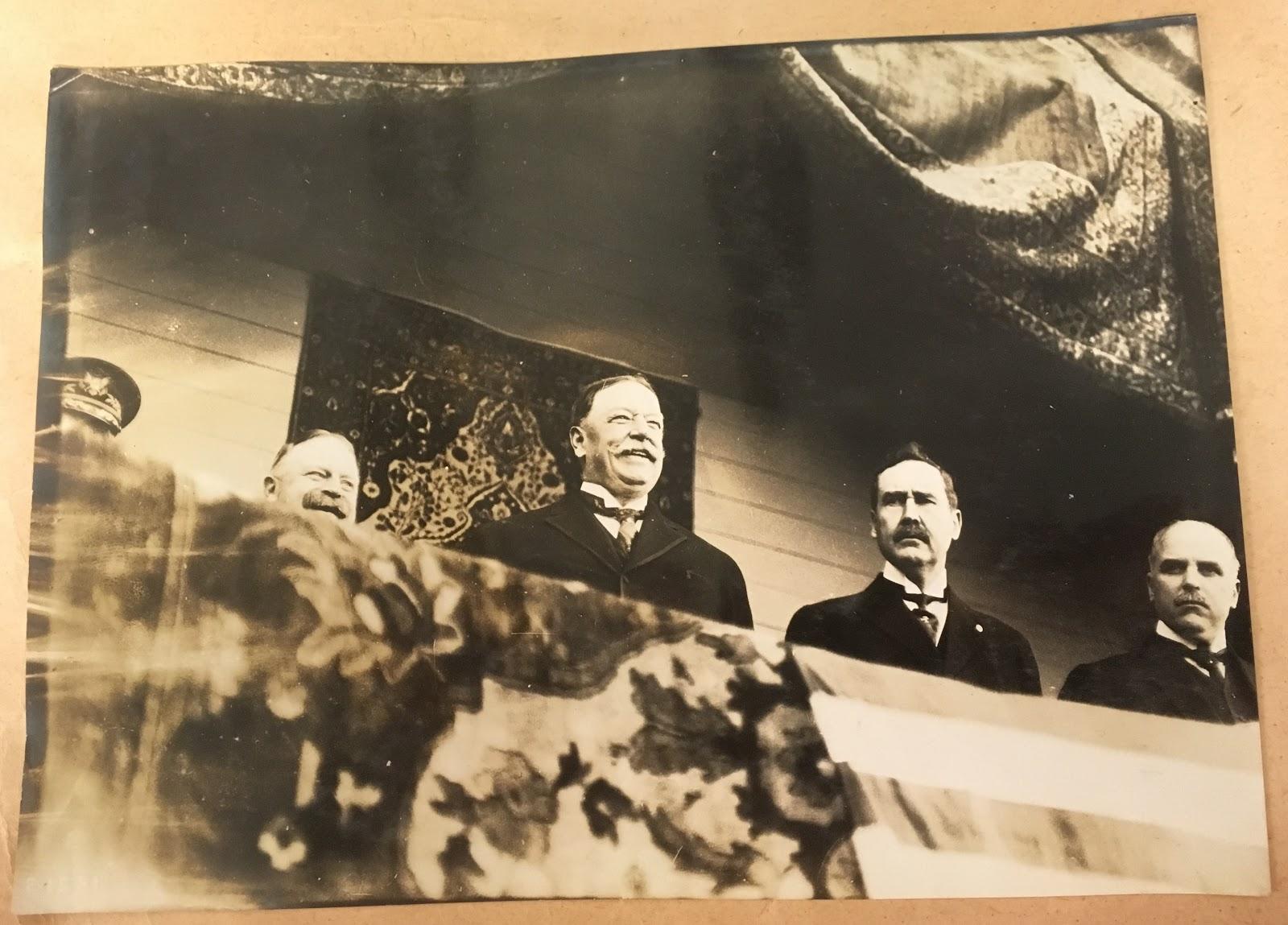
Taft’s visit to the fair was seemingly a large event. He was accompanied wherever he went, soldiers or guards escorting him from building to building. Taft continued to be a very important person at this time. He had lost his reelection to Wilson in 1912, and returned to Yale as a professor of law and government.
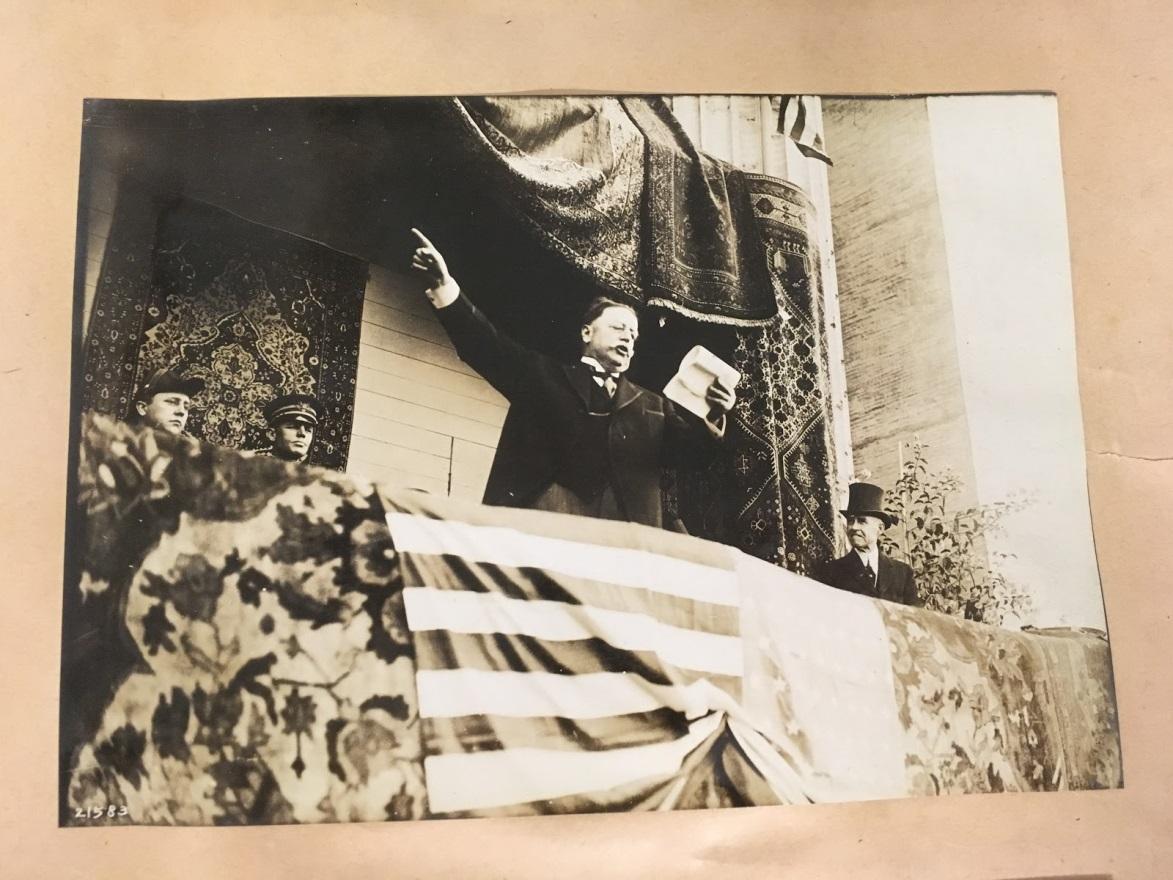
Taft visited many of the fair’s popular buildings and exhibits, including the Japanese Pavilion, Swedish Building, Norway Building, and the art gallery and courtyard of the French Pavilion. He met foreign representatives, fair officials, and experienced much of what the fair had to offer.


And President Taft experienced the unique blend of cultures and stories the fair provided. Here, in my favorite photograph of Taft’s time at the fair, he walks through a hall lined with busts in the Swedish building, flanked by guards. Taft seems enveloped by the art and is perfectly framed between his escorts and the lines of busts, drawing your eye towards Taft at the center. This moment makes a great photograph.
The Bancroft Pictorial team continues to house and describe the collection, and will update this blog with more photographs and details as we progress. Stay tuned!
Faces in the Crowd
In the Bancroft Library Pictorial Unit, work continues on 115 panoramic Cirkut camera negatives being conserved and scanned as part of our NEH-funded work on the Edward A. Rogers Panama-Pacific International Exposition Photograph Collection.

The digital images produced give the chance to peer into these panoramic scenes and pick out small details – and often our gaze is returned by characters in the crowd, caught some 102 years ago.
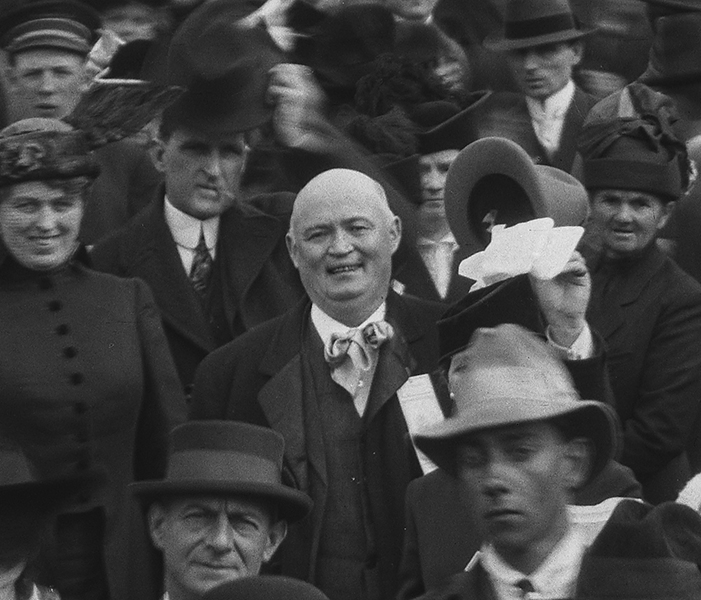
The panorama (pictured above) at the Fillmore Street Gate on San Francisco Day, November 2, 1915, is among the best crowd shots, and all the images in this posting are details from it. At center the throng recedes eastward into the distance, down the thoroughfare of popular amusements known as The Zone. At left the crowds fill the Avenue of Progress which leads toward the bay, past the Machinery Palace. At right are the entrance gates, with the ridge of the Pacific Heights neighborhood beyond.
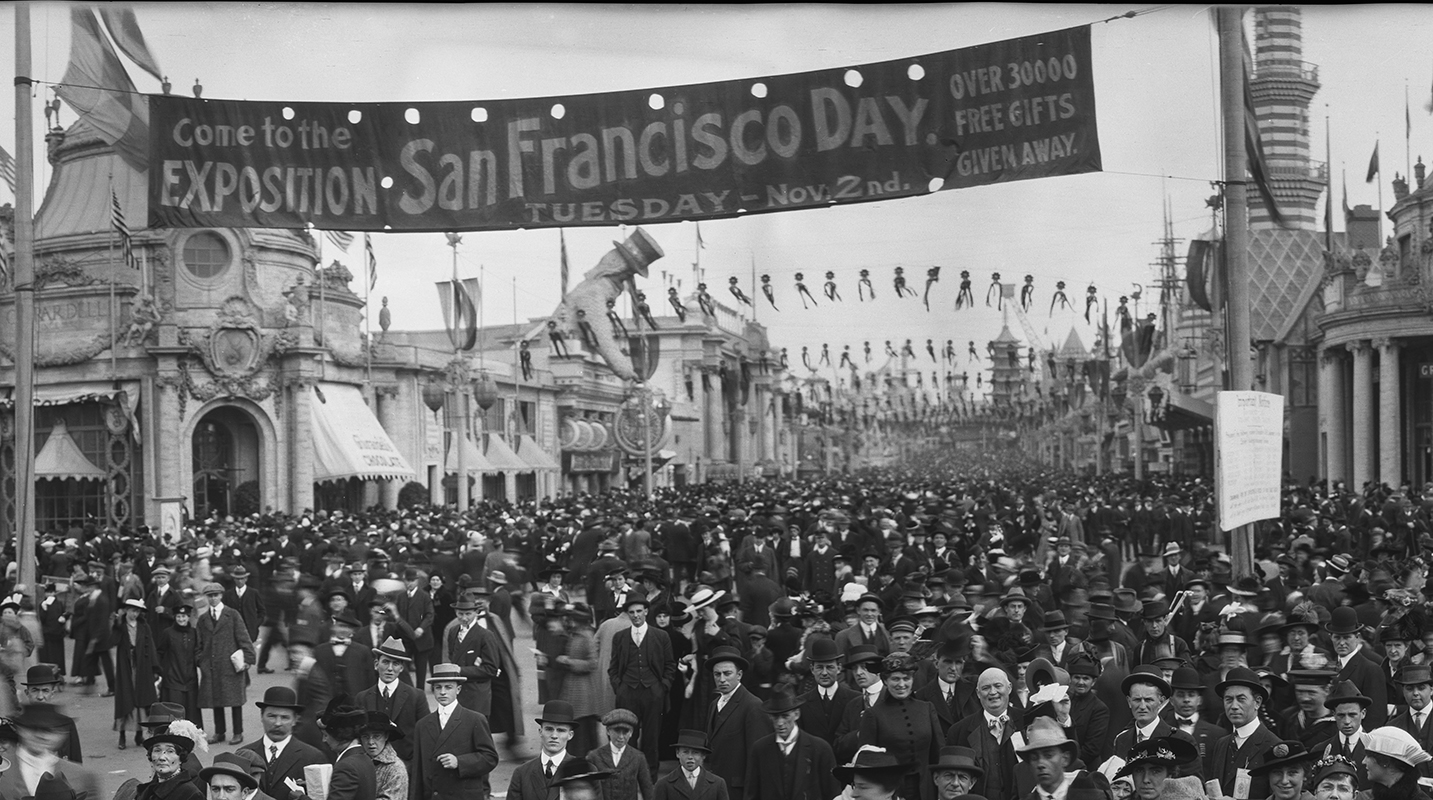
In the crowd there are so many marvelous faces (not to mention terrific hats!) that it is hard to select favorites.
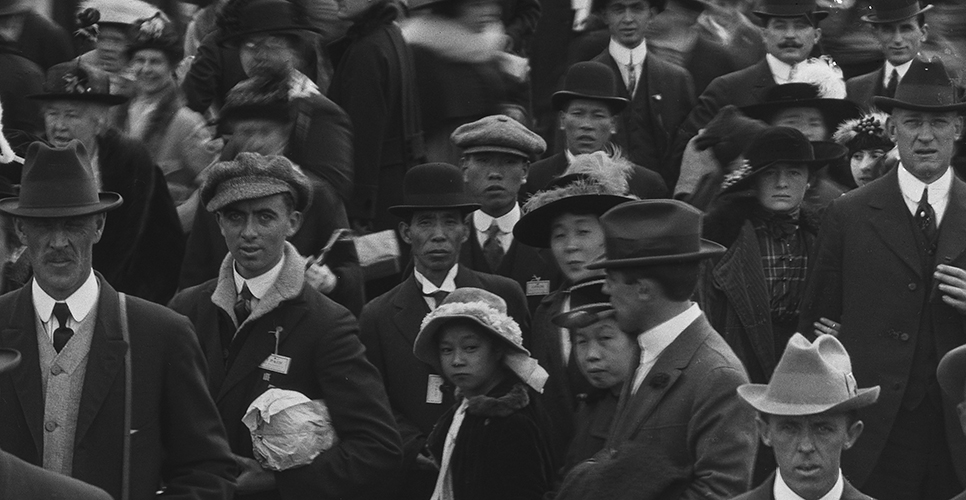
For a “world’s fair” there’s not a lot of diversity in this crowd. But this stylin’ family are holding their own.
###
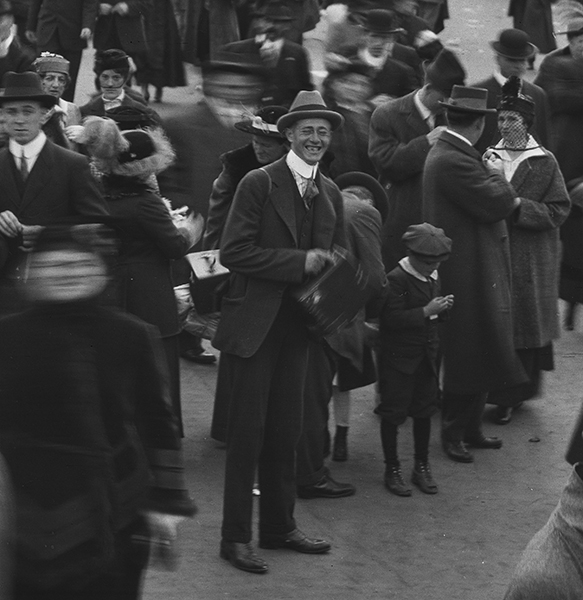
This fellow’s bound to have a good time, and he’s ready to make memories with his handy portable box camera at the ready.
###
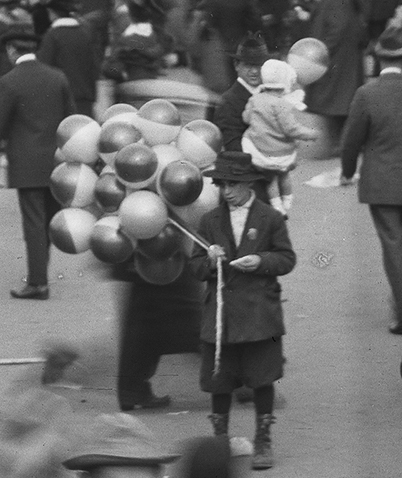
This kid seems to have just made a balloon sale, but it’s serious work.
###
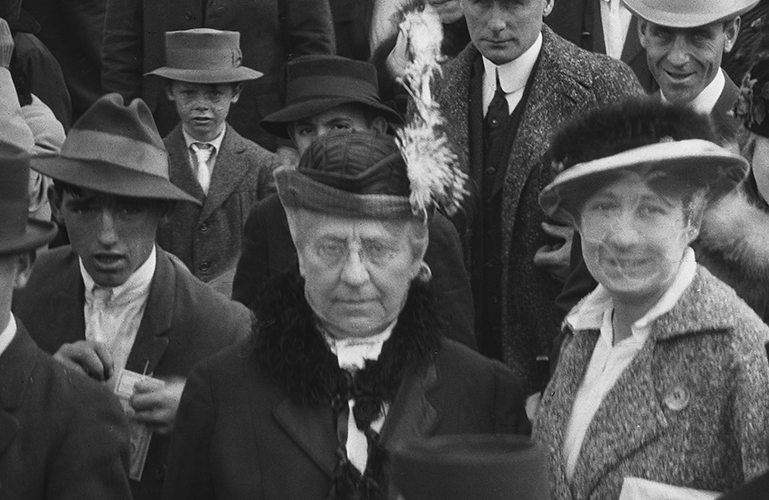
When mixing with hoi polloi, veils and a no-nonsense attitude are necessities for some. Even at a fair.
ESPECIALLY at a fair.
###
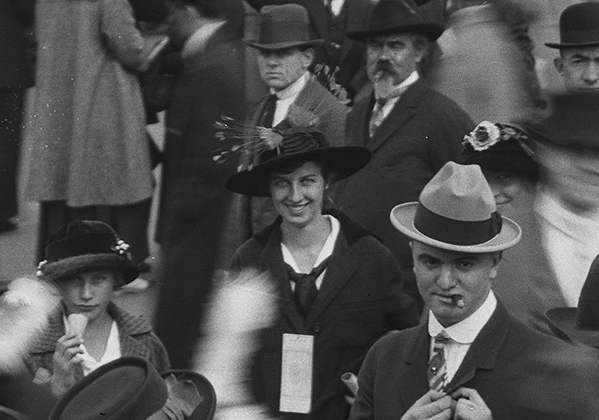
This lady is smiling even though she’s enjoying neither an ice cream nor a cigar. Perhaps she knows her hat is at the cutting edge.
It will be over 40 years before Sputnik challenges her design-forward look.
###
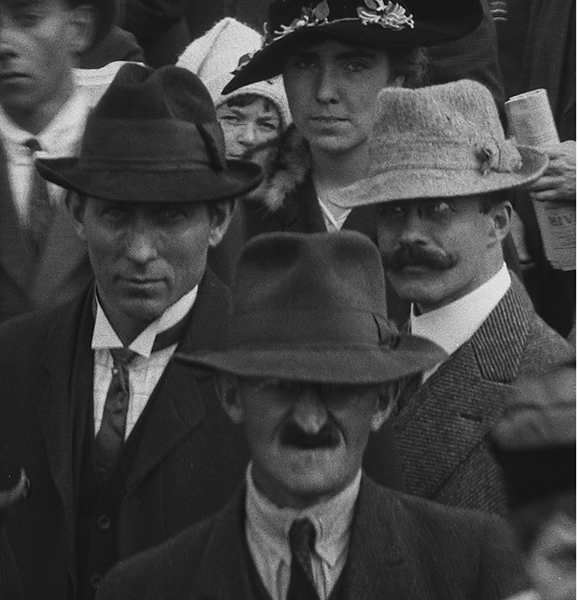
Three distinct kinds of trouble.
Make that four.
###
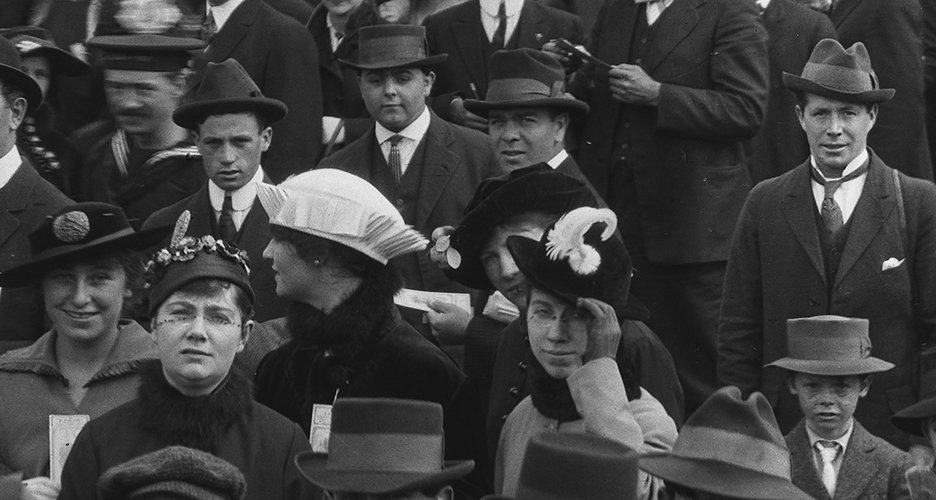
With all the fine hats, how can we choose a winner? – But wait! – Never mind.
The wee chap on the right steals the show!
###
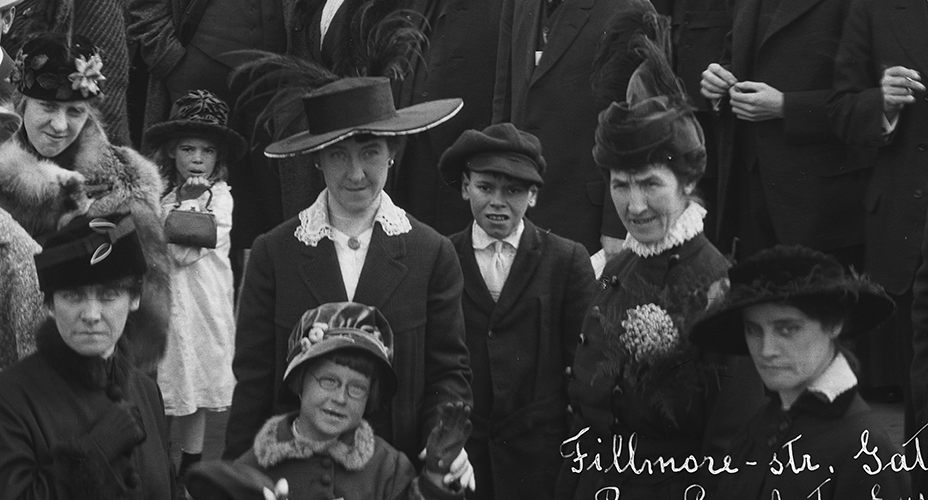
And this favorite auntie’s outstanding chapeau falls victim to another well-accessorized scene-stealer.
###
Work on the Rogers Panama-Pacific International Exposition collection will continue through June of 2018, at which time digital images from over 2,000 negatives will be put online. In the meantime, we will share favorites, along with project updates, on this Bancroft Pictorial Unit blog. Check back again!
James Eason, Archivist for Pictorial Collections, Bancroft Library
Panoramas Revealed: 1915 Panama-Pacific International Exposition Photographic Negatives
This year staff in the Bancroft Pictorial Unit have been hard at work housing and preparing to digitize glass plate negatives from the Edward A. Rogers Panama-Pacific International Exposition (PPIE) Photograph Collection. Supported by funding awarded by the National Endowment for the Humanities (NEH), about 2,000 glass negatives and 115 panoramic film negatives will be put in order, housed in archival sleeves and boxes, listed, and scanned. Although the work will not be complete and online until June 2018, great progress has been made, and we are starting to see some of the images produced by our digital imaging technicians.
The Rogers Collection was a gift presented in late 2014, just months before the centennial of the opening of San Francisco’s great world’s fair. In addition to the negatives (filling about 40 large boxes), there are also huge ledger books containing about 6,700 photographic prints. These originally served as a visual inventory of the negatives, which were mostly produced by the Cardinell-Vincent Company of San Francisco, official photographers for the PPIE. (Others are by the H.S. Crocker Company that previously held the PPIE photo contract.)
The Cardinell-Vincent photograph archive was broken up many decades ago, with much of it sold off in small auction lots in 1979; but Ed Rogers had collected this material well before that sale. In 2014 his was believed to be the largest PPIE photo collection in private hands – and certainly is the largest quantity of glass negatives known to have survived.
The most challenging images to conserve and digitize are the 115 panoramic negatives. These sweeping views and group portraits, made with a pivoting “Cirkut camera,” are on flammable cellulose nitrate film. Handling, transportation, and storage must meet stringent safety requirements. The rolled negatives were soiled from years of warehouse storage, so they are being cleaned by photograph conservators. They are so large (eight or ten inches high and up to 60 inches long!) that they need to be digitally photographed in segments, and these segments are digitally merged to create a file reproducing the original view.
The first scans from these panoramic negatives have been delivered, and they do not disappoint. The broad views over the bay-front PPIE site, just inside the Golden Gate, are stunning.

There is enough detail present to zoom in and closely study segments of the view.


Even the more prosaic group portraits offer great detail and often capture candid moments at the fringes of the crowd. Some of the crowd views are the most entertaining, and place the viewer in festive moment captured 102 year ago.

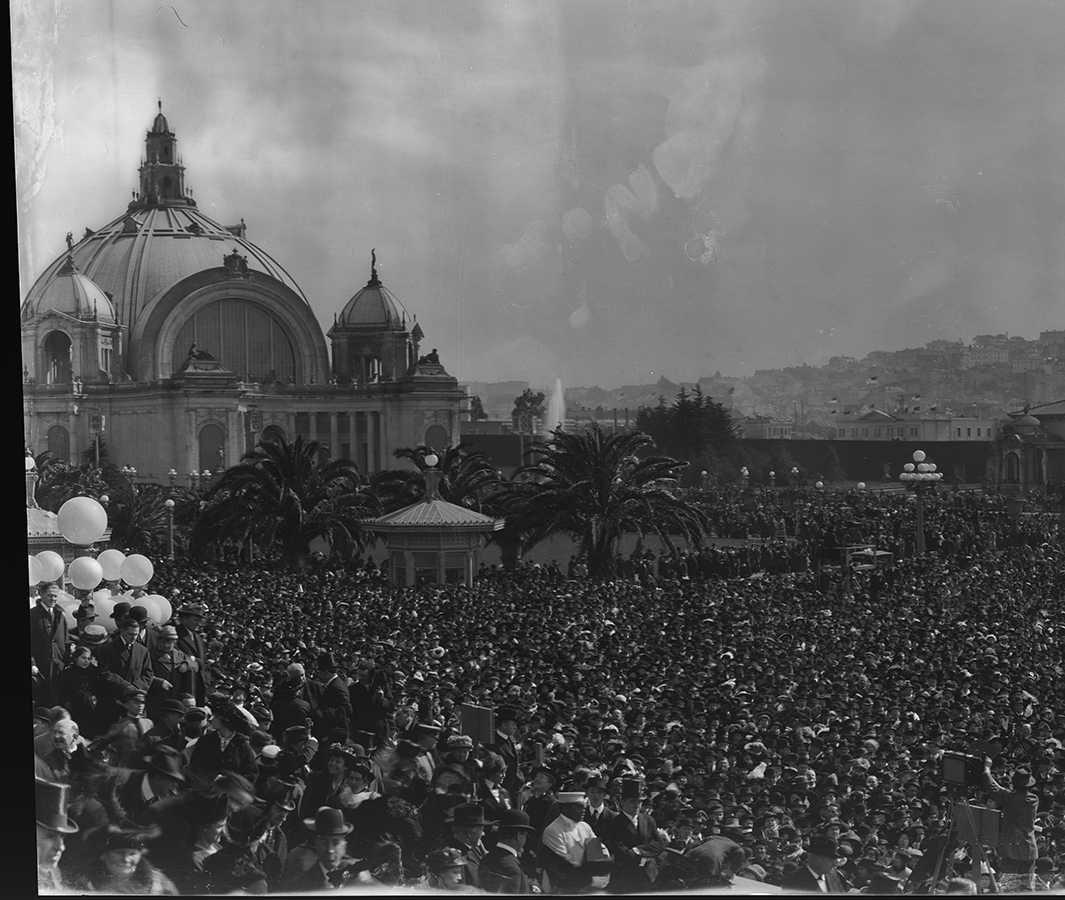
As more digitization is completed we will share favorites, along with project updates, on this Bancroft Pictorial Unit blog. Stay tuned!
James Eason, Archivist for Pictorial Collections, Bancroft Library
